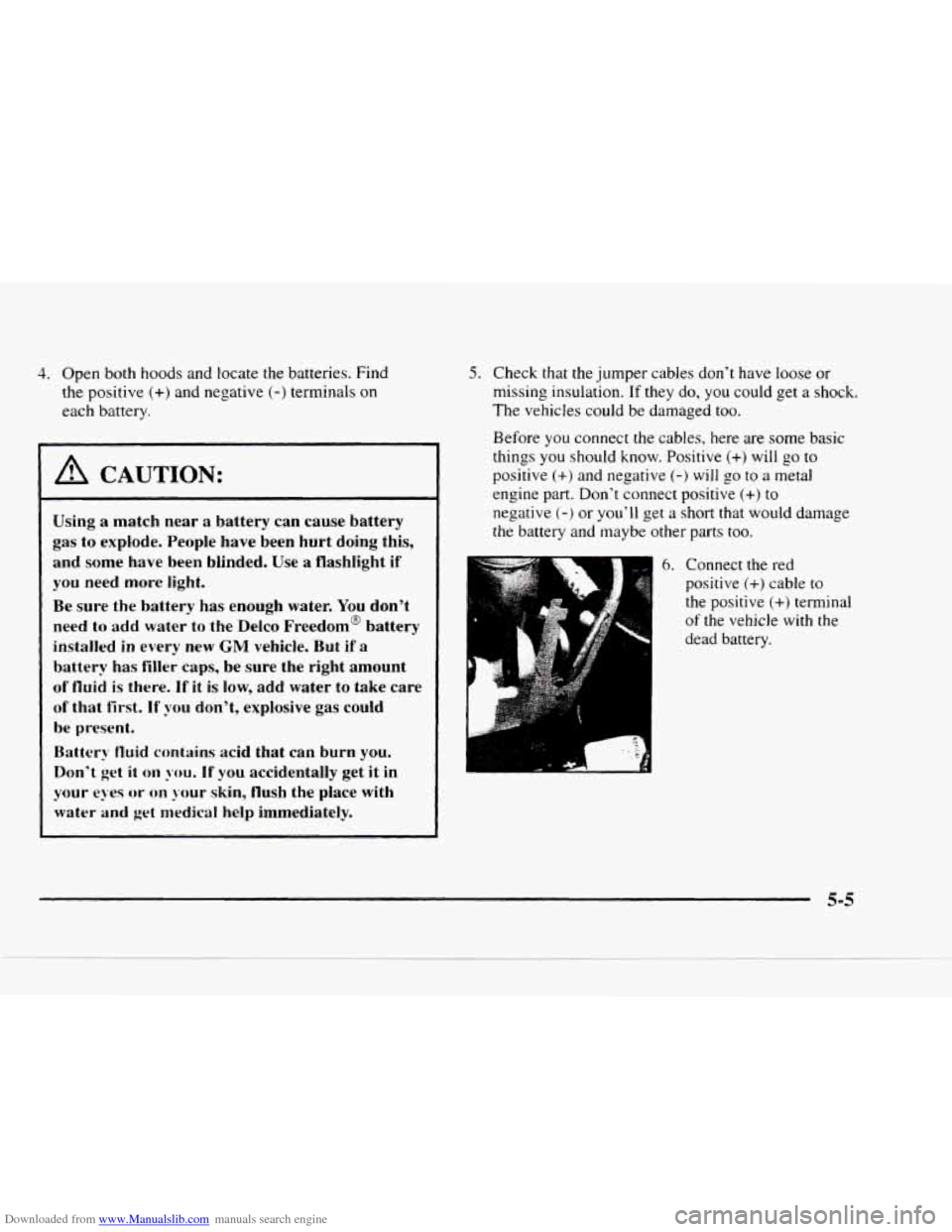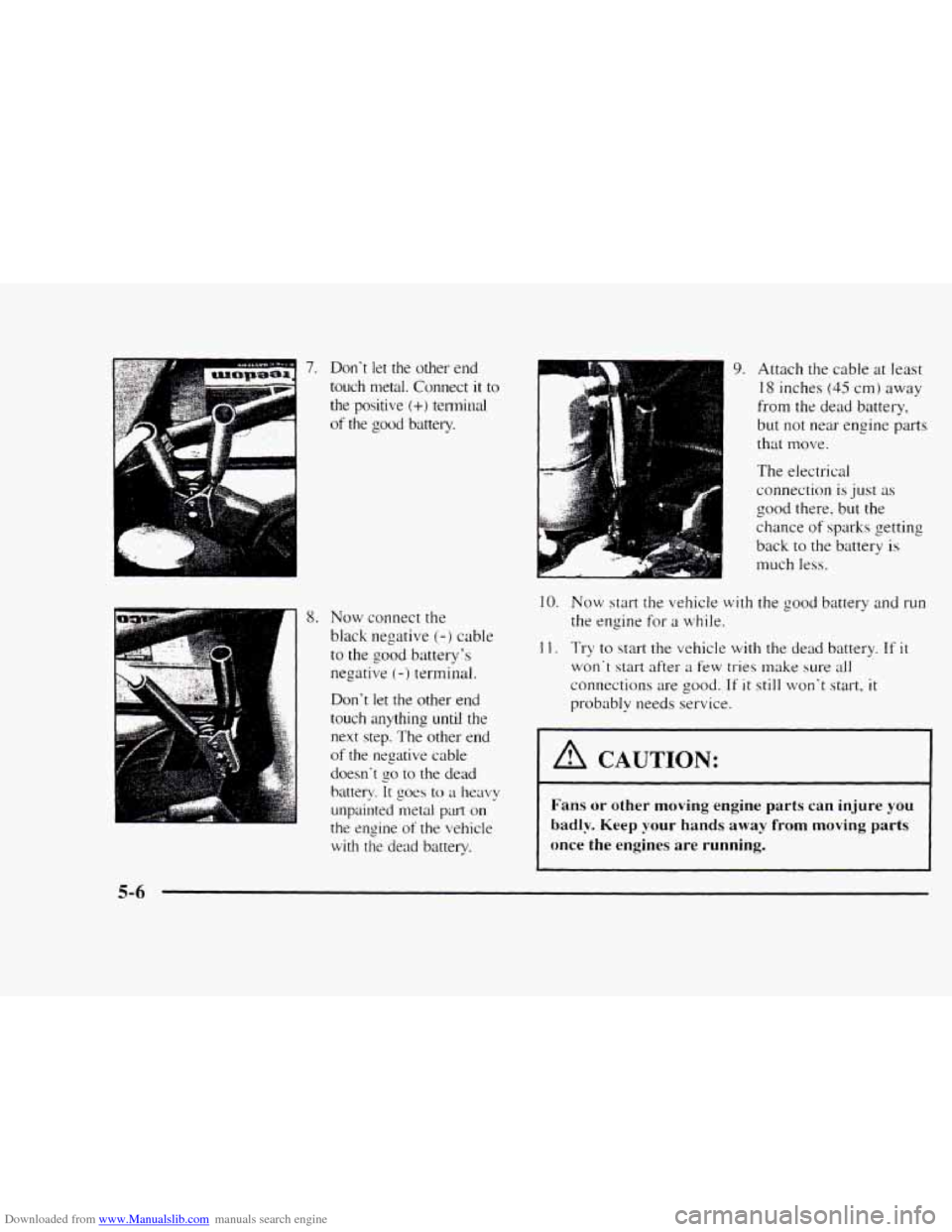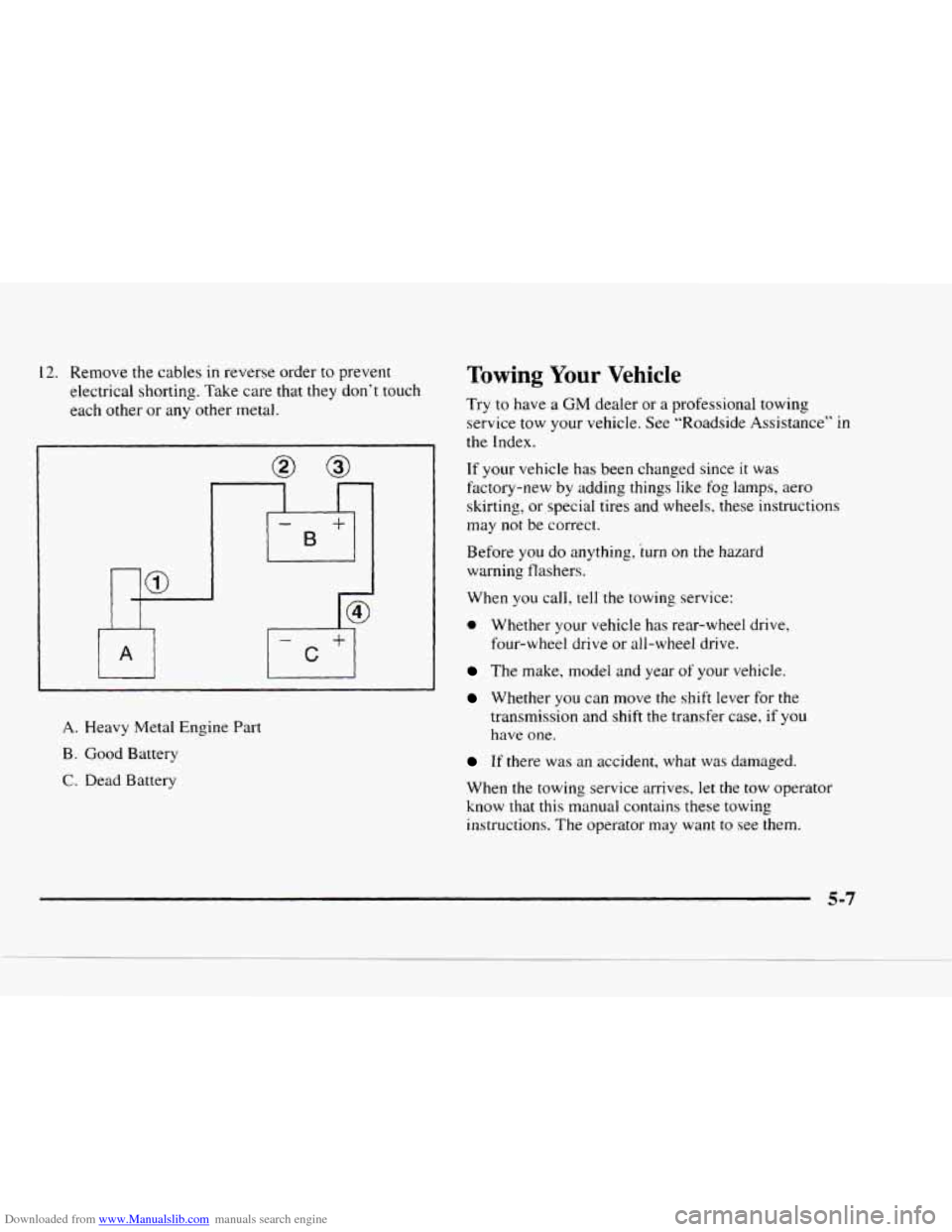Page 202 of 402

Downloaded from www.Manualslib.com manuals search engine Recreational Vehicle Towing (Four-wheel Drive With Manual
Shift Transfer
Case Only)
1. Set the parking brake firmly.
2. Place an automatic transmission in PARK (P) or a
manual transmission in FIRST ( 1 ).
3. Firmly attach the vehicle being towed to the tow
vehicle.
Do not tow the vehicle by the rear bumper
bar. Refer
to the hitch manufacturer’s instructions.
4. Place the manual shift transfer case shift lever in
NEUTRAL
(N).
I A CAUTION:
Shifting the transfer case into NEUTRAL (N) can
cause your vehicle to roll even if the transmission
is in PARK (P), for an automatic transmission, or
if your vehicle is in gear, for a manual
transmission.
You or others could be injured.
Make sure the parking brake
is firmly set before
you shift the transfer case into NEUTRAL
(N).
5. Release the parking brake only after the vehicle
being towed
is firmly attached to the tow vehicle.
6. Insert the ignition key into the ignition switch and
turn it
one notch forward of the LOCK position. This
places the key
in the OFF position, which unlocks
the steering column while preventing battery drain.
Unlocking the steering column
will allow for proper
movement
of the front wheelshires during towing.
4-41
Page 216 of 402

Downloaded from www.Manualslib.com manuals search engine Trailer Wiring Harness
The light duty trailer wiring is a six-wire harness
assembly. The optional heavy-duty trailer wiring is an
eight-wire harness assembly. The harnesses are stored
under the vehicle, along the passenger-side frame
crossmember on two-door vehicles or on the driver’s
side corner frame crossmember on four-door vehicles.
The heavy-duty trailer wiring has
a 30-amp feed wire
with an inline
fuse located by the junction block. See
“Fuses and Circuit Breakers”
in the Index. Both
harnesses have no connector and should be wired by a
qualified electrical technician. The technician can
use
the following color code chart when connecting the
wiring harness
to your trailer.
Dark Blue: Use for electric trailer brakes or
auxiliary wiring.
0 Red: Use for battery charging; it connects to the
starter solenoid (eight-wire harness only).
0 Light Green: Back-up lamps (eight-wire
harness only).
Brown: Taillamps and parking lamps.
0 Yellow: Left stoplamp and turn signal.
0 Dark Green: Right stoplamp and turn signal.
0 White (Heavy Gage): Ground wire.
0 White (Light Gage): Auxiliary stoplamp.
Securely attach the harness
to the trailer, then tape or
strap
it to your vehicle’s frame rail. Be sure you leave it
loose enough so the wiring doesn‘t bend or break, but
not so loose that it drags on the ground. Store the
harness in its original place. Wrap the harness together
and tie
it neatly so it won’t be damaged.
4-55
Page 220 of 402

Downloaded from www.Manualslib.com manuals search engine Jump Starting
If your battery has run down, you may want to use
another vehicle and some jumper cables to start your
vehicle.
But please use the following steps to do
it safely.
NOTICE:
Ignoring these steps could result in costly damage
to your vehicle that wouldn’t be covered
by
your warranty.
Do not try to start your vehicle by pushing or
pulling it. This could damage your vehicle, even if
you have
a manual transmission. And if you have
an automatic transmission, it won’t start that
way.
I A CAUTION:
I
~ Batteries can hurt you. They can be dangerous
1 because:
~ 0 They contain acid that can burn you.
I They contain gas that can explode or ignite.
~ 0 They contain enough electricity to
~ burn you.
~ If you don’t follow these steps exactly, some or all
~ of these things can hurt you.
1. Check the other vehicle. It must have a 12-volt
battery with a negative ground system.
I NOTICE:
If the other system isn’t a 12-volt system with a
negative ground, both vehicles can be damaged.
5-3
Page 222 of 402

Downloaded from www.Manualslib.com manuals search engine 4. Open both hoods and locate the batteries. Find
the positive
(+) and negative (-) terminals on
each battery.
I A CAUTION:
Using a match near a battery can cause battery
gas to explode. People have been hurt doing this,
and some have been blinded. Use a flashlight if
you need more light.
Be sure the battery has enough water.
You don’t
need to add water to the Delco Freedom@ battery
installed
in every new GM vehicle. But if a
battery has filler caps, be sure the right amount
of fluid is there. If it is low, add water to take care
of that first. If you don’t, explosive gas could
be present.
Battery
fluid contains acid that can burn you.
Don’t get it on
~ou. If you accidentally get it in
your eyes
or on your skin, flush the place with
water
and get medical help immediately.
5. Check that the jumper cables don’t have loose or
missing insulation.
If they do, you could get a shock.
The vehicles could be damaged too.
Before
you connect the cables, here are some basic
things
you should know. Positive (+) will go to
positive (+) and negative (-) will go to a metal
engine part. Don’t connect positive
(+) to
negative (-) or you’ll get a short that would damage
the battery and maybe other parts too.
of the vehicle with the
dead battery.
5-5
Page 223 of 402

Downloaded from www.Manualslib.com manuals search engine 7. Don‘t let the other end
touch metal. Connect
it to
the positive
(+) tennitla1
of the good battery.
8. Now connect the
black negative
(-) cable
to the good battery’s
negative
(-) terminal.
Don’t let the other end
touch anything
until the
next step. The
other end
of the negative cable
doesn’t
$0 to the dead
battery.
It goes to a hewy
unpainted metal
part on
the engine of the vehicle
with the dead battery.
9. Attach the cable at least
18 inches (45 cm) away
from the dead battery,
but not
near engine parts
that move.
The electrical
connection
is just as
b wod there, but the
chance
of sparks getting
back
to the battery is
much less.
10. Now start the vehicle with the good battery and run
the engine for a while.
1 1. Try to start the vehicle with the dead battery. If it
won‘t start after a few tries make sure all
connections are good. If it still won’t start, it
probably needs service.
1 A CAUTION: I
Fans or other moving engine parts can injure you
badly. Keep your hands away from moving parts
once the engines are running.
5-6
Page 224 of 402

Downloaded from www.Manualslib.com manuals search engine 12. Remove the cables in reverse order to prevent
electrical shorting. Take care that they don’t touch
each other or any other metal.
-0
A
A. Heavy Metal Engine Part
B. Good Battery
C. Dead Battery
Towing Your Vehicle
Try to have a GM dealer or a professional towing
service tow your vehicle. See “Roadside Assistance” in
the index.
If your vehicle has been changed since it was
factory-new by adding things like fog lamps, aero
skirting,
or special tires and wheels, these instructions
may not be correct.
Before
you do anything, turn on the hazard
warning flashers.
When you call, tell the towing service:
e Whether your vehicle has rear-wheel drive,
four-wheel drive
or all-wheel drive.
The make, model and year of your vehicle.
Whether you can move the shift lever for the
transmission and shift the transfer
case, if you
have one.
If there was an accident, what was damaged.
When the towing service arrives, let
the tow operator
know that this manual contains these towing
instructions.
The operator may want to see them.
5-7
Page 256 of 402

Downloaded from www.Manualslib.com manuals search engine Section 6 Service and Appearance Care
Here you will find information about the care of your vehicle. This section begins with service and fuel information,
and then
it shows how to check important fluid and lubricant levels. There is also technical information about your
vehicle, and a part devoted
to its appearance care.
6-3
6-4
6-5
6-6
6-9 6-
13
6- 14
6-18
6- 19
6-
20
6-2 1
6-23
6-26
6-26
6-26 6-27
Fuel
Fuels in Foreign Countries
Filling Your Tank
Checking Things Under the Hood
Engine Oil
Air Cleaner
Automatic Transmission Fluid
Manual Transmission Fluid
Hydraulic Clutch
Rear Axle
Four-wheel Drive and All-Wheel Drive
Engine Coolant Radiator Pressure Cap
Thermostat Power Steering Fluid
Windshield Washer Fluid 6-28
6-32
6-3 3 6-3 8
6-40 6-49
6-49
6-52
6-54
6-5
7
6-5 8
6-58
6-58
6-62
6-63
6-64
Brakes
Battery
Bulb Replacement
Windshield Wiper Blade Replacement
Tires
Appearance Care
Cleaning the Inside
of Your Vehicle
Care
of Safety Belts
Cleaning the Outside of Your Vehicle
Appearance Care Materials Chart
Vehicle Identification Number
(VIN)
Service Parts Identification Label
Electrical System
Replacement Bulbs
Capacities and Specifications
Air Conditioning Refrigerants
Page 263 of 402
Downloaded from www.Manualslib.com manuals search engine When you lift the hood. you'll see these items:
B -- ."*f . ..
A. Battery
B. Coolant Recovery Tank
C. Engine Oil Dipstick
*
C
D. Transmission Dipstick
E. Engine Oil Fill
F. Power Steering Reservoir
G. Brake Master Cylinder
H. Air Cleaner
I. Windshield Washer Fluid
6-8